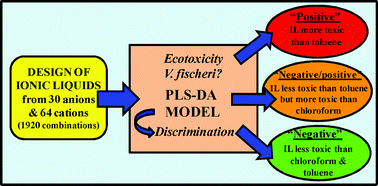Ionic liquids have attracted a lot of attention as potential replacements for conventional volatile organic solvents, although they may pose environmental risks to aquatic ecosystems that have to be assessed. There is strong interest in developing mathematical models to estimate the ecotoxicity of ionic liquids, minimising the experimental investigations and the consequent consumption of time and resources. This paper presents a new approach for estimating the ecotoxicity of ILs, based on the standardised assay with the bacterium Vibrio fischeri, by means of the application of Partial Least Squares-Discriminant Analysis (PLS-DA). The PLS-DA model developed makes it possible to discriminate ionic liquids, formed by combinations of 30 anions and 64 cations, on the basis of their expected toxicity with respect to conventional solvents that they may replace. The successful results obtained in the validation of the model reveal that this approach can be useful as a screening tool to easily aid, from the early stages of the process, the design of aquatic environmentally friendly ionic liquids. This approach may also be useful for the further development of predictive models based on other aquatic organisms, for which more data are expected to be available in the near future.

You have access to this article
 Please wait while we load your content...
Something went wrong. Try again?
Please wait while we load your content...
Something went wrong. Try again?


 Please wait while we load your content...
Please wait while we load your content...